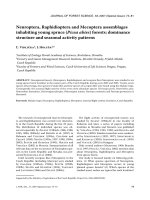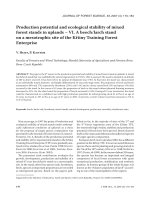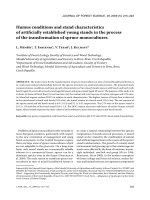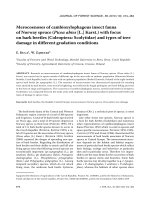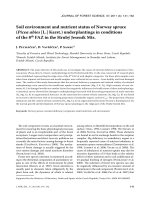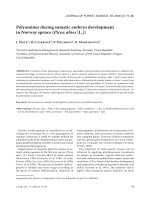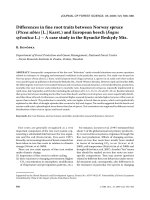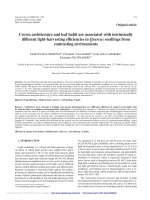Báo cáo lâm nghiệp: "Neuroptera, Raphidioptera and Mecoptera assemblages inhabiting young spruce (Picea abies) forests: dominance structure and seasonal activity patterns" docx
Bạn đang xem bản rút gọn của tài liệu. Xem và tải ngay bản đầy đủ của tài liệu tại đây (454.05 KB, 8 trang )
J. FOR. SCI., 53, 2007 (Special Issue): 74–81 74
JOURNAL OF FOREST SCIENCE, 53, 2007 (Special Issue): 74–81
Neuroptera, Raphidioptera and Mecoptera assemblages
inhabiting young spruce (Picea abies) forests: dominance
structure and seasonal activity patterns
Ľ. V
1
, J. H
2,3
1
Institute of Zoology Slovak Academy of Sciences, Bratislava, Slovakia
2
Forestry and Game Management Research Institute, Jíloviště-Strnady, Frýdek-Místek,
Czech Republic
3
Faculty of Forestry and Wood Sciences, Czech University of Life Sciences Prague, Prague,
Czech Republic
ABSTRACT: Neuropteroid insects (Neuroptera, Raphidioptera) and scorpion flies (Mecoptera) were studied in six
young spruce forest localities in the eastern part of the Czech Republic during years 2005 and 2006. Twenty-seven
species of lacewings, four species of snake flies and four species of scorpion flies were found using the Malaise traps.
Consequently, the seasonal flight activity of the seven most abundant species (Chrysopa perla, Hemerobius pini,
Hemerobius humulinus, Dichrostigma flavipes, Phaeostigma notata, Panorpa communis and Panorpa germanica) is
discussed.
Keywords: Malaise traps; Neuroptera; Raphidioptera; Mecoptera; seasonal flight activity; faunistics; Czech Republic
Supported by the Ministry of Agriculture of the Czech Republic, Project No. MZe 0002070201.
e research of neuropteroid insects (Neuropte-
ra and Raphidioptera) was carried very intensive-
ly in the Czech Republic during the last 25 years.
e distribution of individual species was ob-
served especially by Z (1984a,b, 1986, 1988,
1995, 2004, 2005a,b) and B et al. (1997) in
Bohemia and C (1995a), C and
Z (1995), Š (1995a, 1997, 1998, 1999a,
2003), Š and H (1995), H and
V (2002) in Moravia. Summarization of all
relevant data on the occurrence of Neuroptera spe-
cies in the Czech Republic and Slovakia was pre-
sented by J et al. (2004).
Until recently scorpion flies (Mecoptera) in the
Czech Republic (including Moravia) were studied
by C (1985a,b, 1995b), Š (1995b,
1999b), Š and H (1994), T
and L (1986) and Z (2005c).
e flight activity of neuropteroid insects was
studied by Z (1984a,b) in one locality of
Bohemia and later, a series of papers including
localities in Slovakia and Moravia was published
by V (1994, 1995, 1998) and H and
V (2002). Similar researches were conduct-
ed by S (1992, 1997), S
and K (2002), S et al. (1995)
and V et al. (2001) in Hungary.
Only several authors (M 1960; B
et al. 1997; H, V 2002) mention data
about Neuroptera, Raphidioptera and Mecoptera
from spruce forest.
Our study is focused mainly on following prob-
lems. (i) What species spectrum of Neuroptera,
Raphidioptera and Mecoptera occurs in young
planted spruce forests? (ii) Which species of the
studied insect orders are typical for such localities?
75 J. FOR. SCI., 53, 2007 (Special Issue): 74–81
(iii) What are the flight activity patterns of domi-
nant species in young spruce forests?
MATERIAL AND METHODS
e study area is situated in the eastern part of
the Czech Republic. e study was carried out in
the industrially affected region (Ostravská pánev
Plateau) with forest coverage 9–20% (dominance
of Norway spruce, Picea abies, 30–50%) and in the
Nízký Jeseník Hills (forest coverage 70%, domi-
nance of Norway spruce 67.8%) (C 1996).
e Norway spruce dominates in both studied re-
gions, however other tree species as larch (Larix
sp.), beech (Fagus sp.), pine (Pinus sp.), oak (Quer-
cus sp.), lime (Tilia sp.), birch (Betula sp.) are also
present. Woods form a heterogenic mosaic of dif-
ferently aged spruce forests.
e neuropteroid insects (Neuroptera, Raphi-
dioptera) and scorpion flies (Mecoptera) were col-
lected by Malaise traps of T (1972) type
(modified and made by f. Entomologické pomôcky,
Bratislava, RNDr. O. Šauša). e Malaise trap is a
passive, non-powered and continuously operating
tent-like trap. Its height is 2 m and collecting surface
is approximately 6 m
2
. Collecting sheets are black
and a covering sheet is white. e trap is anchored
to the ground by ropes and metal hooks. During
2005–2006, one trap was placed in each of six lo-
calities (Kyjovice: 49°49'30.17''N, 18°3'4.38''E, 390 m
a.s.l.; Pustá Polom: 49°51'38.05''N,18°0'16.99''E, 430 m
a.s.l.; Podvihov: 49°51'36.47''N, 17°58'46.72''E, 460 m
a.s.l.; Lesní Albrechtice: 49°48'21.09''N, 17°53'4.78''E,
460 m a.s.l.; Skřipov: 49°48'39.08''N, 17°52'59.02''E,
480 m a.s.l.; Paskov: 49°42'43.34''N, 18°16'45.7''E,
270 m a.s.l.) in very young spruce forests (10–20-
year-old). All Malaise traps were installed in small
forest clearings, minimally 30 m inwards the forest.
e forest clearings are covered mainly by rough
reedgrass (Calamagrostis arundinacea) and shrubs
like bird cherry (Padus racemosa) are growing there
occasionally too. e traps were exposed from the
beginning of April to the end of October. From April
to July, they were emptied every second or third day
and from August to October, they were emptied
monthly (J. Holuša leg.).
Figs. 1a–f display only the time period in which
selected species were recorded.
RESULTS AND DISCUSSION
Altogether nearly 2,000 specimens from the or-
ders Neuroptera, Raphidioptera and Mecoptera
including 35 species of 7 families were collected
during a two-year research (2005–2006). All data
regarding species richness and species dominance
detected in each locality are presented in Table 1
(Neuroptera), Table 2 (Raphidioptera) and Table 3
(Mecoptera). Considering our research took place
only in spruce forests, the number of species found
is very high. In total, 78 species of Neuroptera
(J et al. 2004) were previously recorded in
Moravia what means that 27 species found (Table 1)
represent 35% of the entire species richness.
All studied localities can be divided into two
groups according to the species frequency what is
obvious mainly in Neuroptera. e highest species
richness was ascertained in the villages Lesní Al-
brechtice and Skřipov (18, resp. 17 species of Neu-
roptera) and a slightly lower number was found in
the village Podvihov (14 species). e second group
includes the localities Kyjovice, Pustá Polom and
Paskov (9, 8, resp. 7 species). When we add next
two species of Neuroptera which were found in the
locality Paskov in 1998 (H, V 2002),
a total of nine species is known from this locality.
e higher species composition could be a result
of the spruce forest decline caused by drought and
infestation by honey fungus. By comparison, other
localities are covered with much closer and denser
spruce forests as in the surroundings of Skřipov.
Localities Lesní Albrechtice and Skřipov.
Spe-
cies Chrysopa perla and Hemerobius humulinus
were very abundant in both localities. Species
Chrysoperla carnea s.l. was abundant only in these
localities. Species Nineta flava, Nineta pallida,
Chrysotropia ciliata, Chrysopa pallens, Hemerobius
stigma, Wesmaelius nervosus, Drepanepteryx pha-
laenoides, Coniopteryx pygmaea and Myrmeleon
formicarius did not occur in other surveyed areas.
Several of them live sparsely in coniferous forests.
Hemerobius atrifrons is associated with European
larch (Larix decidua) (A et al. 1980). e
rare snake fly species Inocellia crassicornis, which
distribution data for Silesia and Northern Moravia
regions were summarized by Š (1995a), was
collected in Lesní Albrechtice.
Locality Kyjovice.
Euryoecic species Chrysopa
perla, Hemerobius humulinus and Micromus va-
riegatus are very abundant in coniferous and de-
ciduous forests (A et al. 1980). Hemerobius
pini, typical for pine trees (Pinus sp.) (A et
al. 1980), was also numerous in this locality. e
Siberian faunistic elements predominated in this
locality. Regarding snake flies (Raphidioptera), the
most abundant species were typical for pine and
spruce forests (Dichrostigma flavipes, Phaeostigma
notata) (A et al. 1980).
J. FOR. SCI., 53, 2007 (Special Issue): 74–81 76
Fig. 1. Flight activity of selected dominant species of Neuroptera, Raphidioptera and Mecoptera on Malaise-trapping sites
Hemerobius pini
0
5
10
15
20
25
30
35
40
45
50
1 2 3 4 5 6 7 8 9 10 11 12 13 14 15 16 17
(week)
ex.
Pustá Polom 2005 n = 43
Podvihov 2005 n = 87
April I May I June I July I August
a
n
n
Hemerobiusȱpini
0
2
4
6
8
10
12
1 2 3 4 5 6 7 8 9 10 11 12 13 14 15 16 17
(week)
ex.
Skìípovȱ2005ȱȱȱnȱ=ȱ20
Skìípovȱ2006ȱȱȱnȱ=ȱ31
AprilȱȱȱIȱȱȱȱȱȱȱȱȱMayȱȱȱȱȱȱȱȱȱȱIȱȱȱȱȱȱȱȱȱȱȱȱJuneȱȱȱȱȱȱȱȱȱȱȱIȱȱȱȱȱȱȱȱȱJulyȱȱȱȱȱȱȱȱȱȱȱȱȱIȱȱȱȱȱȱȱȱAugustȱ
b
Chrysopaȱperla
0
5
10
15
20
25
30
35
1 2 3 4 5 6 7 8 9 10 11 12 13 14 15 16 17
(week)
ex.
PustáȱPolomȱ2005ȱȱȱnȱ=ȱ142
Kyjoviceȱ2006ȱȱȱȱȱȱȱȱȱȱnȱ=ȱ13
AprilȱȱȱIȱȱȱȱȱȱȱȱȱMayȱȱȱȱȱȱȱȱȱȱȱIȱȱȱȱȱȱȱȱȱȱȱȱJuneȱȱȱȱȱȱȱȱȱȱIȱȱȱȱȱȱȱȱȱȱȱJulyȱȱȱȱȱȱȱȱȱȱȱIȱȱȱȱȱȱȱȱAugustȱ
c
Chrysopa perla
0
5
10
15
20
25
30
1 2 3 4 5 6 7 8 9 10 11 12 13 14 15 16 17
(week)
ex.
Podvihov 2006 n = 42
Lesní Albrechtice 2006 n = 48
April I May I June I July I August
d
Hemerobiusȱhumulinusȱ
0
2
4
6
8
10
12
14
1 2 3 4 5 6 7 8 9 10 11 12 13 14 15 16 17
(week)
ex.
PustáȱPolomȱ2006ȱȱnȱ=ȱ14
Skìípovȱ2006ȱȱȱȱȱȱȱȱȱȱnȱ=ȱ47
AprilȱȱȱIȱȱȱȱȱȱȱȱȱȱȱMayȱȱȱȱȱȱȱȱȱIȱȱȱȱȱȱȱȱȱȱȱȱJuneȱȱȱȱȱȱȱȱȱȱȱIȱȱȱȱȱȱȱȱȱȱJulyȱȱȱȱȱȱȱȱȱȱȱȱȱIȱȱȱȱȱȱȱȱAugustȱ
e
Dichrostigmaȱflavipes
ȱandȱ
Phaeostigmaȱnotata
0
5
10
15
20
25
1 2 3 4 5 6 7 8 9 10 11 12 13 14 15 16 17
(week)
ex.
DfȱSkìipovȱ2006ȱȱȱȱȱȱnȱ=ȱ34
PnȱPodvihovȱ2005ȱȱȱnȱ=ȱ48
ȱAprilȱȱȱIȱȱȱȱȱȱȱȱȱȱMayȱȱȱȱȱȱȱȱȱIȱȱȱȱȱȱȱȱȱȱȱȱȱJuneȱȱȱȱȱȱȱȱȱȱIȱȱȱȱȱȱȱȱȱȱȱJulyȱȱȱȱȱȱȱȱȱȱȱȱIȱȱȱȱȱȱȱȱAugustȱ
f
Panorpaȱgermanica
0
5
10
15
20
25
April May June July August September October
ex.
Skìipovȱ2005ȱȱȱnȱ=ȱ15
Skìipovȱ2006ȱȱȱnȱ=ȱ28
g
Panorpaȱcommunis
0
10
20
30
40
50
60
70
April May June July August September October
ex.
Kyjoviceȱ2006ȱȱȱȱȱȱȱȱȱȱnȱ=ȱ83
PustáȱPolomȱ2006ȱȱȱnȱ=ȱ80
h
Locality Pustá Polom. Species Chrysopa perla,
Hemerobius humulinus and Hemerobius pini pre-
dominated. Species Micromus angulatus, which
occur mainly on low vegetation in warmer locali-
ties (A et al. 1980), was very abundant here.
e rare species Conwentzia pineticola associated
with coniferous forests, living mainly on pine trees
(Z 1961), was trapped here too. Only a few
localities with occurrence of this species have been
published from Moravia (Z 1995; Š
1997, 2003). Snake fly Xanthostigma xanthostigma
is predominantly associated with pines (Pinus),
Skřipov 2005 n = 20
Skřipov 2006 n = 31
n
n
n
n
n
n
April May June July August September October April May June July August September October
Pustá Polom 2006 n = 14
Skřipov 2006 n = 47
Df Skřipov 2006 n = 34
Pn Podvihov 2005 n = 48
Skřipov 2005 n = 15
Skřipov 2006 n = 28
77 J. FOR. SCI., 53, 2007 (Special Issue): 74–81
Table 1. List of recorded Neuroptera species and their dominance distribution (%)
Neuroptera
Kyjovice Pustá Polom Podvihov
Lesní
Albrechtice
Skřipov Paskov
2005 2006 2005 2006 2005 2006 2005 2006 2005 2006 2005 2006
Chrysopidae
Nineta Navás, 1912
– flava (Scopoli, 1763) 2.5
– pallida (Schneider, 1846) 1.2 2.8
Chrysotropia Navás, 1911
– ciliata (Wesmael, 1841) 1.2
Chrysopa Leach, 1815
– pallens (Rambur, 1838) 3.5 7.0
– perla (Linnaeus, 1758) 79.5 26.5 74.3 35.7 27.3 33.6 32.1 56.5 28.2 16.8 20.0 33.3
Dichochrysa Yang, 1991
– flavifrons (Brauer, 1850) 0.8
– prasina (Burmeister, 1839) 0.7 0.8 0.7
– ventralis (Curtis, 1834) 2.0 0.5 2.4 1.2 2.4 26.7 16.7
Peyerimhoffina Lacroix, 1920
– gracilis (Schneider, 1851) 0.8 2.5 7.0 3.5
Chrysoperla Steinmann, 1964
– carnea s.l. (Stephens, 1836) 15.4 1.1 7.1 2.2 9.6 21.0 9.4 15.5 9.8 16.7
Hemerobiidae
Hemerobius Linnaeus, 1758
– humulinus Linnaeus, 1758 22.5 20.0 0.7 7.2 10.6 32.9 6.7 16.7
– stigma Stephens, 1836 1.4 0.7
– pini Stephens, 1836 14.3 22.5 10.0 62.6 19.2 22.2 7.1 39.4 21.7 26.7 16.7
– atrifrons McLachlan, 1868 2.5
– nitidulus Fabricius, 1777 0.7 0.8
– micans Olivier, 1792 2.0 0.7 1.6 2.5 2.1
– lutescens Fabricius, 1793 0.7 0.8
Wesmaelius Kruger, 1922
– nervosus (Fabricius, 1793) 0.7
– quadrifasciatus (Reuter, 1894) 8.2 2.8 1.4
– subnebulosus (Stephens, 1836) 0.7 1.6 2.4 1.4 0.7 6.7
Drepanepteryx Leach, 1815
– phalaenoides (Linnaeus, 1758) 1.2 1.4
Micromus Rambur, 1842
– variegatus (Fabricius, 1793) 5.1 20.4 2.9 2.9 8.8 6.2 3.5 6.7
– angulatus (Stephens, 1836) 4.1 1.6 22.9 0.7 12.0 3.7 2.4
Coniopterygidae
Coniopteryx Curtis, 1834
– pygmaea Enderlein, 1906 1.2 0.7
Conwentzia Enderlein, 1905
– pineticola Enderlein, 1905 1.4 0.7
Semidalis Enderlein, 1905
– aleyrodiformis (Stephens, 1836) 1.2 6.7
Myrmeleontidae Latreille, 1802
Myrmeleon Linnaeus, 1767
– formicarius Linnaeus, 1767 0.7
Number of species 3 8 5 7 11 14 13 11 9 15 7 5
Number of individuals 39 49 191 70 139 125 81 85 71 143 15 6
Total number of species 9 8 14 18 17 7
Total number of individuals 88 261 264 166 214 21
J. FOR. SCI., 53, 2007 (Special Issue): 74–81 78
spruces and oaks (Quercus) (A et al. 1980;
Š 1995a).
Locality Podvihov.
e species Hemerobius pini
and Chrysopa perla were typical. An occurrence of
two xerotermous species, Dichochrysa flavifrons
and Micromus angulatus, is very interesting. Di-
chochrysa flavifrons occurs in deciduous forests
only sporadically (recorded in silver fir forest and
pine forest – S 2001). Micromus an-
gulatus was also in spruce forest in the High Tatras
Mts. (unpublished data) however its eudominant
representation in spruce forest is not typical. A
very similar representation of this species detected
S (2001) in pine forest in Hungary.
Locality Paskov.
Only euryoecic species oc-
curred in this locality, though in a low abundance.
In the same locality, the flight activity of Neuro-
ptera was recorded almost five times higher during
a previous research (
H, V 2002). e
actual low value was probably caused by an unsuit
-
able trap location.
e frequency of some species allowed study-
ing their seasonal flight activity. Species Hemero-
bius pini (Figs. 1a,b) began to appear in the mid of
April. e occurrence increases at the end of May
what corresponds with the observation of H
and V (2002) in spruce forests of Paskovský
les and Kabátice in 1998. e second peak was re-
Table 2. List of recorded Raphidioptera species and their dominance distribution (%)
Raphidioptera
Kyjovice Pustá Polom Podvihov
Lesní
Albrechtice
Skřipov Paskov
2005 2006 2005 2006 2005 2006 2005 2006 2005 2006 2005 2006
Raphidiidae
Xanthostigma xanthostigma
(Schummel, 1832)
6.2 – 5.3 100 1.3 37.8 – 7.1 2.8 – 100 66.7
Dichrostigma flavipes (Stein, 1863) 50.0 100 63.1 – 34.7 53.3 82.6 78.6 68.6 89.5 – –
Phaeostigma notata (Fabricius, 1781) 43.8 31.6 – 64.0 8.9 17.4 7.1 28.6 10.5 – 33.3
Inocellidae
Inocellia crassicornis (Schummel, 1832) – – – – – – – 7.1 – – – –
Number of species 3 1 3 1 3 3 2 4 3 2 1 2
Number of individuals 16 12 19 2 75 45 23 14 35 38 1 3
Total number of species 3 3 3 4 3 2
Total number of individuals 28 21 120 37 73 4
Table 3. List of recorded Mecoptera species and their dominance distribution (%)
Mecoptera
Kyjovice Pustá Polom Podvihov
Lesní
Albrechtice
Skřipov Paskov
2005 2006 2005 2006 2005 2006 2005 2006 2005 2006 2005 2006
Panorpidae
Panorpa Linnaeus, 1758
– communis Linnaeus, 1758 33.9 52.2 54.5 70.2 27.5 44.1 44.1 34.3 17.5 20.0 38.1 16.7
– vulgaris Omhoff, Labram, 1845 27.1 22.7 15.2 12.3 42.5 39.7 11.8 28.6 7.0 5.0 14.3 –
– germanica Linnaeus, 1758 3.4 9.4 3.0 13.1 22.5 14.7 44.1 37.1 66.7 70.0 38.1 66.6
– alpina Rambur, 1842 35.6 15.7 27.3 4.4 7.5 1.5 – – 8.8 5.0 9.5 16.7
Number of species 4 4 4 4 4 4 3 3 4 4 4 3
Number of individuals 59 159 33 114 40 68 34 35 57 40 21 6
Total number of species 4 4 4 3 4 4
Total number of individuals 218 147 108 69 97 27
79 J. FOR. SCI., 53, 2007 (Special Issue): 74–81
corded in July (Skřipov 2005) or in August (Skřipov
2006). Z (1984a) noticed a high abundance
of this species in Prague in September. In the inves-
tigated areas, no flight activity of this species was
recorded in September.
Chrysopa perla was active from the end of May
to the mid of August. e activities in Pustá Po-
lom, Podvihov and Lesní Albrechtice (Figs. 1c,d)
reached the peak in the mid of June. Females oc-
curred mainly in July and at the end of season.
V (1994) recorded the peak of the activity
in the mid of May in Ivanka pri Dunaji (Slovakia),
but this locality is markedly xerotermous with de-
ciduous trees. H and V (2002) ob-
served the peak of its activity in spruce forests of
Paskovský les and Loucký les at the end of May in
1998. e delay of its flight activity in highlands,
compared to lowlands, is in accordance with re-
sults of S (1997).
Hemerobius humulinus (Fig. 1e) is a common
species in the Czech Republic, having probably two
generations and regularly occurring in coniferous
trees. We recorded this species from the mid of
May to the mid of August with the peak of its activ-
ity at the beginning of July.
e flight activity of snake fly Phaeostigma notata
was very short, from May to June, with the highest
activity at the beginning of June (Fig. 1f). A similar
pattern of flight activity was found in Dichrostigma
flavipes, but its activity peaked at the end of June
(Fig. 1f). e males prevailed in the trap collections
in both species during the whole season.
Panorpa communis was the most abundant Me-
coptera species in spruce forests. Its flight activity
increased from the end of May to the end of July,
then decreased considerably (Fig. 1h). A very simi-
lar pattern of flight activity was recorded in Panorpa
germanica (Fig. 1g). e ratio of females increased
at the end of season in both species.
Based on our results (Table 1), we can specify
some typical species associated with spruce trees
(regular representation in all or nearly all investi-
gated areas, dominant representation at least in one
studied area): Chrysopa perla, Dichochrysa ventra-
lis, Chrysoperla carnea s.l., Hemerobius humulinus,
Hemerobius pini, Wesmaelius subnebulosus, Micro-
mus variegatus and Micromus angulatus.
R e f er en c es
ASPÖCK H., ASPÖCK U., HÖLZEL H., 1980. Die Neuropte-
ren Europas I. Krefeld, Goecke & Evers: 495.
BEZDĚK A., HŮRKA K., ZELENÝ J., 1997. Společenstva
střevlíkovitých brouků (Coleoptera: Carabidae) a síťo-
křídlých (Neuroptera) mokřadu Černiš. In: Sborník
Jihočeského muzea v Českých Budějovicích, Přírodní vědy,
37: 53–61.
CHLÁDEK F., 1985a. Bittacus hageni Brauer, 1860 – neu für
die Tschechoslowakei (Mecoptera, Bittacidae). Articulata,
2: 159.
CHLÁDEK F., 1985b. K rozšíření srpic v Československu
(Mecoptera). Zprávy Československé společnosti entomo-
logické při ČSAV, 21: 43–45.
CHLÁDEK F., 1995a. K rozšíření síťokřídlých (Planipennia)
na Moravě a Slovensku. Selene,
4: 2–4.
CHLÁDEK F., 1995b. Mecoptera. In: ROZKOŠNÝ R.,
VAŇHARA J. (eds), Terrestrial Invertebrates of the Pálava
Biosphere Reserve of UNESCO, II. Folia Facultatis Scien-
tarum Naturalium Universitatis Masarykiana Brunensis,
Biologia, 93: 227–229.
CHLÁDEK F., ZELENÝ J., 1995. Raphidioptera. In:
ROZKOŠNÝ R., VAŇHARA J. (eds), Terrestrial Inverte-
brates of the Pálava Biosphere Reserve of UNESCO, II. Folia
Facultatis Scientarum Naturalium Universitatis Masarykia-
na Brunensis, Biologia, 93: 217–219.
CULEK M. (ed.), 1996. Biogeografické členění České repub-
liky. Praha, Enigma: 348.
HOLUŠA J., VIDLIČKA Ľ., 2002. Chrysopids and Hemero-
biids (Plannipenia) of young spruce forests in the eastern
part of the Czech Republic. Journal of Forest Science, 48:
432–440.
JEDLIČKA L., ŠEVČÍK J., VIDLIČKA Ľ., 2004. Checklist of
Neuroptera of Slovakia and the Czech Republic. Biológia
(Bratislava), 59 (Supplementum 15): 59–67.
MARTINEK V., 1960. Insecta, Arachnoidea a Diplopoda
smrkových kultur střední Evropy. Rozpravy Českosloven-
ské Akademie Věd, Řada Matematické a přírodní vědy,
70: 1–143.
SZENTKIRÁLYI F., 1992. Spatio-temporal patterns of brown
lacewings based on the Hungarian light trap network
(Insecta: Neuroptera: Hemerobiidae). In: CANARD M.,
ASPÖCK H., MANSELL M.W. (eds), Current Research
in Neuropterology. Proceedings of the Fourth Interna-
tional Symposium on Neuropterology, Toulouse, Sacco:
349–357.
SZENTKIRÁLYI F., 1997. Seasonal flight patterns of some
common brown lacewing species (Neuroptera, Hemero-
biidae) in Hungarian agricultural regions. Biológia (Brati-
slava), 52: 291–302.
SZENTKIRÁLYI F., 2001. Chapter 10: Lacewings in ve-
getables, forests, and other crops. In: EWEN P., NEW
T.R., WHITTINGTON A. (eds), Lacewings in Crop
Environments. Cambridge, Cambridge University Press:
239–291.
SZENTKIRÁLYI F., KAZINCZY L., 2002. Seasonal flight pat-
terns of antlions (Neuroptera, Myrmeleontidae) monitored
by the Hungarian light trap network. Acta Zoologica Scien-
tiarium Hungaricae, 48 (Supplementum 2): 311–328.
J. FOR. SCI., 53, 2007 (Special Issue): 74–81 80
SZENTKIRÁLYI F., PLANT C.W., HONEK A., RILEY A.,
1995. Latitudinal variation in seasonal flight pattern of
European brown lacewing (Neuroptera, Hemerobiidae).
In: DEMETER A., PEREGOVITS L. (eds), Ecological Proc-
esses: Current Status and Perspectives. Abstracts of the
7
th
European Ecological Congress, Budapest: 68.
ŠEVČÍK J., 1995a. Dlouhošíjky (Insecta: Neuropteroidea:
Raphidioptera) Slezska a severní Moravy – současný
stav znalostí. Časopis Slezského Muzea Opava (A), 44:
251–258.
ŠEVČÍK J., 1995b. Nález srpice Panorpa hybrida McLachlan,
1882 (Mecoptera: Panorpidae) na severní Moravě. Časopis
Slezského Muzea Opava (A), 44: 185–186.
ŠEVČÍK J., 1997. New and interesting records of Neuroptera
and Raphidioptera from Moravia and the Czech part of
Silesia. Klapalekiana, 33: 75–82.
ŠEVČÍK J., 1998. Příspěvek k poznání síťokřídlých (Neu-
roptera) Hrubého Jeseníku (Česká republika). Časopis
Slezského Muzea Opava (A), 47: 225–232.
ŠEVČÍK J., 1999a. Neuroptera. In: OPRAVILOVÁ V.,
VAŇHARA J., SUKOP I. (eds), Aquatic Invertebrates of
the Pálava Biosphere Reserve of UNESCO. Folia Facultatis
Scientarum Naturalium Universitatis Masarykiana Bru-
nensis, Biologia, 101: 199–200.
ŠEVČÍK J., 1999b. Notes on the distribution of Panorpa scor-
pionflies (Mecoptera: Panorpidae) in Moravia and Silesia
(Czech Republic). Klapalekiana, 35: 41–47.
ŠEVČÍK J., 2003. Neuropteroidní hmyz (Insecta: Neuro-
pterida) CHKO Poodří (Česká republika) včetně kvanti-
tativních údajů z lužního lesa. Časopis Slezského Muzea
Opava (A), 52: 1–22.
ŠEVČÍK J., HUDEČEK J., 1994. Srpice (Insecta: Mecoptera)
Slezska a severní Moravy – současný stav znalostí a přehled
zjištěných druhů. Časopis Slezského Muzea Opava (A),
43: 253–261.
ŠEVČÍK J., HUDEČEK J., 1995. Síťokřídlí (Insecta: Neuro-
pteroidea: Planipennia) Slezska a severní Moravy – přehled
dosavadních znalostí. Časopis Slezského Muzea Opava
(A), 44: 141–156.
TAJOVSKÝ K., LAUTERER P., 1986. Contributon to the
knowledge of the genus Bittacus Latreille, 1802 (Meco-
ptera, Bittacidae) in Czechoslovakia. Časopis Moravského
Muzea, Vědy přírodní, 71: 189–193.
TOWNES H., 1972. A light-weight Malaise trap. Entomologi-
cal News, 83: 239–247.
VAS J., MARKÓ V., MÉSZÁROS Z., ÁBRAHÁM L., 2001.
Study of Neuropteroidea (Raphidioptera, Neuroptera)
communities by using Malaise traps in an untreated
orchard and its environment. Acta Phytopathologica et
Entomologica Hungarica, 36: 115–122.
VIDLIČKA L., 1994. Flight activity of some Planipennia
species. Biológia (Bratislava), 49: 729–737.
VIDLIČKA L., 1995. Seasonal flight activity of Planipennia
species at the Devínska Kobyla hill (West Carpathians).
Biológia (Bratislava), 50: 151–156.
VIDLIČKA Ľ., 1998. Letová aktivita sieťokrídlovcov (Plani-
pennia) na lokalite Kamenec pod Vtáčnikom v Chránenej
krajinnej oblasti Ponitrie. Rosalia, 13: 117–120.
ZELENÝ J., 1961. Differentiation of Conwentzia psociformis
Curt. from Conwentzia pineticola End. (Neuroptera).
Časopis Československé Společnosti Entomologické, 58:
55–67.
ZELENÝ J., 1984a. Flight activity of Czechoslovak Hemerobii-
dae and Chrysopidae: investigation by light trap. In: GEPP
J., ASPÖCK H., HÖLZEL H. (eds), Progress in World’s
Neuropterology. Proceedings of the 1
st
International Sym-
posium on Neuropterology, Graz: 173–178.
ZELENÝ J., 1984b. Chrysopid occurence in West Palearctic
temperate forest and derived biotops. In: CANARD M.,
SÉMÉRIA Y., NEW T.R. (eds), Biology of Chrysopidae.
e Hague, Boston, Lancaster: 151–160.
ZELENÝ J., 1986. Síťokřídlí (Planipennia) přirozených a an-
tropicky podmíněných ekosystémů. Zprávy Československé
Zoologické Společnosti, 19–20: 98–99.
ZELENÝ J., 1988. Fauna síťokřídlých (Planipennia, Insecta)
Podbrdska. Vlastivědný sborník Podbrdska, 27: 103–114.
ZELENÝ J., 1995. Planipennia. In: ROZKOŠNÝ R.,
VAŇHARA J. (eds), Terrestrial Invertebrates of the Pálava
Biosphere Reserve of UNESCO, II. Folia Facultatis Scien-
tarum Naturalium Universitatis Masarykiana Brunensis,
Biologia, 93: 221–226.
ZELENÝ J., 2004. Neuropteroidea a Mecoptera Šumavy.
Aktuality šumavského výzkumu, 2: 202–205.
ZELENÝ J., 2005a. Raphidioptera (dlouhošíjky). In: FARKAČ
J., KRÁL D., ŠKORPÍK M. (eds), Červený seznam ohro-
žených druhů České republiky. Bezobratlí. Agentura ochra-
ny přírody a krajiny ČR: 161–162.
ZELENÝ J., 2005b. Neuroptera (síťokřídlí). In: FARKAČ J.,
KRÁL D., ŠKORPÍK M. (eds), Červený seznam ohrožených
druhů České republiky. Bezobratlí. Agentura ochrany
přírody a krajiny ČR: 163–165.
ZELENÝ J., 2005c. Mecoptera (srpice). In: FARKAČ J., KRÁL
D., ŠKORPÍK M. (eds), Červený seznam ohrožených druhů
České republiky. Bezobratlí. Agentura ochrany přírody
a krajiny ČR: 166–167.
81 J. FOR. SCI., 53, 2007 (Special Issue): 74–81
Společenstva Neuroptera, Raphidioptera a Mecoptera mladých smrkových
(Picea abies) lesů: struktura dominance a sezonní aktivita
ABSTRAKT: Síťokřídlý hmyz (Neuroptera, Raphidioptera) a srpice (Mecoptera) šesti lokalit umístěných v mladých
smrkových porostech ve východní části České republiky jsme studovali v letech 2005 a 2006. Bylo zjištěno 27 druhů
zlatooček, denivek, bělotek a mravkolvů, čtyři druhy dlouhošíjek a čtyři druhy srpic. V článku se diskutuje o letové
aktivitě sedmi nejpočetnějších druhů (Chrysopa perla, Hemerobius pini, Hemerobius humulinus, Dichrostigma fla-
vipes, Phaeostigma notata, Panorpa communis a Panorpa germanica).
Klíčová slova: Malaiseho lapač; Neuroptera; Raphidioptera; Mecoptera; sezonní letová aktivita; faunistika; Česká
republika
Corresponding author:
Ing. J H, Ph.D., Výzkumný ústav lesního hospodářství a myslivosti, v.v.i., Jíloviště-Strnady,
pracoviště Frýdek-Místek, Nádražní 2811, 738 01 Frýdek-Místek, Česká republika
tel./fax: + 420 558 628 647, e-mail:
